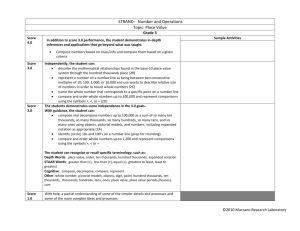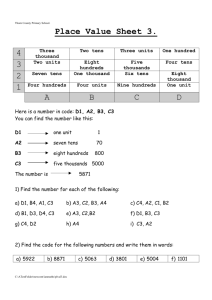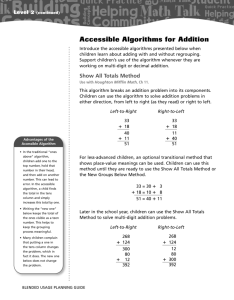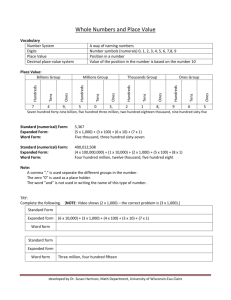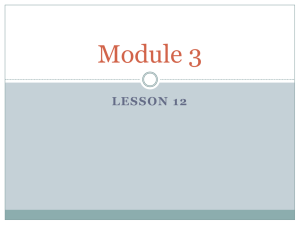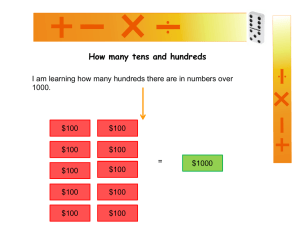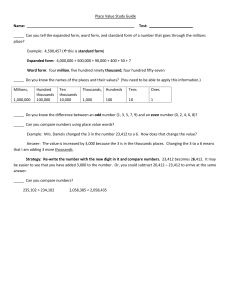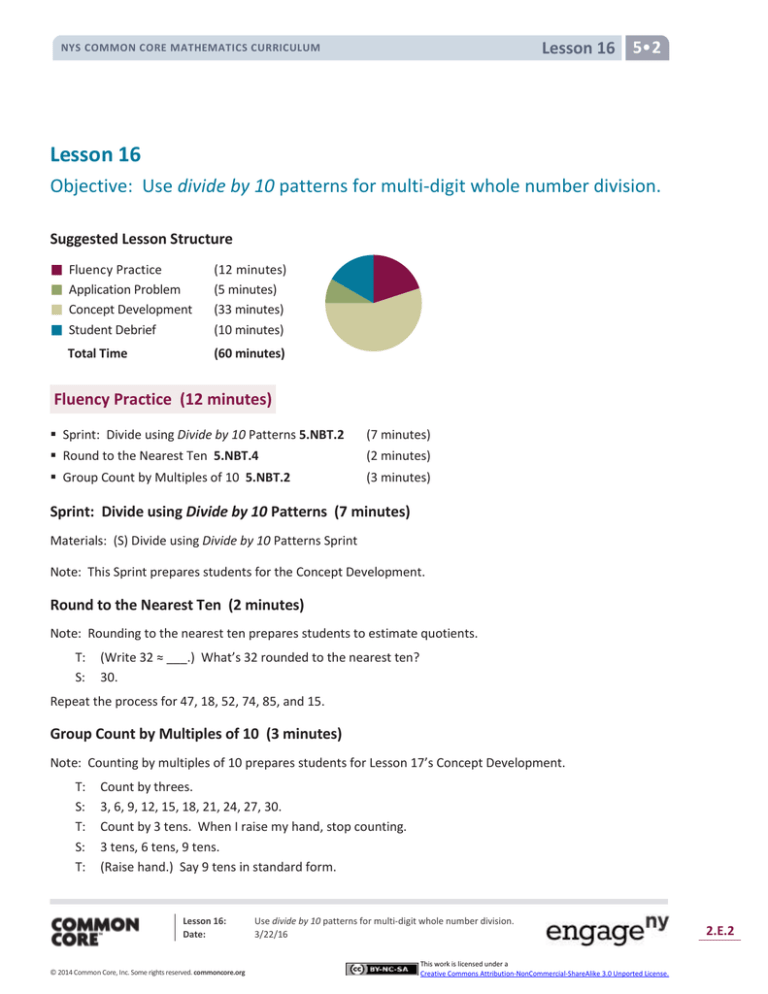
Lesson 16 5•2
NYS COMMON CORE MATHEMATICS CURRICULUM
Lesson 16
Objective: Use divide by 10 patterns for multi-digit whole number division.
Suggested Lesson Structure
Fluency Practice
Application Problem
Concept Development
Student Debrief
Total Time
(12 minutes)
(5 minutes)
(33 minutes)
(10 minutes)
(60 minutes)
Fluency Practice (12 minutes)
Sprint: Divide using Divide by 10 Patterns 5.NBT.2
(7 minutes)
Round to the Nearest Ten 5.NBT.4
(2 minutes)
Group Count by Multiples of 10 5.NBT.2
(3 minutes)
Sprint: Divide using Divide by 10 Patterns (7 minutes)
Materials: (S) Divide using Divide by 10 Patterns Sprint
Note: This Sprint prepares students for the Concept Development.
Round to the Nearest Ten (2 minutes)
Note: Rounding to the nearest ten prepares students to estimate quotients.
T:
S:
(Write 32 ≈ ___.) What’s 32 rounded to the nearest ten?
30.
Repeat the process for 47, 18, 52, 74, 85, and 15.
Group Count by Multiples of 10 (3 minutes)
Note: Counting by multiples of 10 prepares students for Lesson 17’s Concept Development.
T:
S:
T:
S:
T:
Count by threes.
3, 6, 9, 12, 15, 18, 21, 24, 27, 30.
Count by 3 tens. When I raise my hand, stop counting.
3 tens, 6 tens, 9 tens.
(Raise hand.) Say 9 tens in standard form.
Lesson 16:
Date:
© 2014 Common Core, Inc. Some rights reserved. commoncore.org
Use divide by 10 patterns for multi-digit whole number division.
3/22/16
This work is licensed under a
Creative Commons Attribution-NonCommercial-ShareAlike 3.0 Unported License.
2.E.2
Lesson 16 5•2
NYS COMMON CORE MATHEMATICS CURRICULUM
S:
90.
Continue the process, stopping at 15 tens, 24 tens, and 30 tens.
Repeat the process with 6 tens, stopping periodically.
Application Problem (5 minutes)
The area of a rectangular vegetable garden is 200 ft2. The width is 10 ft. What is the length of the vegetable
garden?
Note: This problem provides a nice opportunity to quickly
address area concepts and division by a power of ten, allowing
for a smooth transition into the day’s Concept Development.
While solving, students should be encouraged to draw a
picture of a rectangle to support their work.
Concept Development (33 minutes)
NOTES ON
MULTIPLE MEANS
OF ENGAGEMENT:
Materials: (S) Personal white board
Problem 1: 420 ÷ 10
T:
(Write 420 ÷ 10 horizontally on board.) Let’s use place
value disks to solve this problem. Work with a partner
to show 420 using the disks.
T/S: (Draw 4 hundred disks and 2 ten disks, as shown to the
lower right.)
T: Say 420 in unit form.
S: 4 hundreds 2 tens.
T: Let’s divide. What is 1 hundred divided by 10?
S: 10.
T: If 1 hundred divided by 10 is 1 ten, what is 4 hundreds
divided by 10?
S: 4 tens.
T: I’ll show that division with my place value disks. You
do the same. (Draw an arrow showing ÷ 10 and 4 tens
disks.)
S: (Draw.)
T: What is 1 ten divided by 10?
S: 1.
T: If 1 ten divided by 10 is 1 one, what is 2 tens divided by 10?
Lesson 16:
Date:
© 2014 Common Core, Inc. Some rights reserved. commoncore.org
The disk representations used here are
a shorthand version of the work done
in Grade 5, Module 1 with place value
charts. Some students may need to
see the division on the chart using
arrows before moving directly to drawn
disks.
Use divide by 10 patterns for multi-digit whole number division.
3/22/16
This work is licensed under a
Creative Commons Attribution-NonCommercial-ShareAlike 3.0 Unported License.
2.E.3
Lesson 16 5•2
NYS COMMON CORE MATHEMATICS CURRICULUM
S:
T:
T:
S:
T:
S:
T:
S:
T:
S:
T:
S:
T:
S:
T:
S:
2 ones.
Show that division with place value disks.
(Point to the original problem.) Read the division sentence with the solution.
420 ÷ 10 = 42.
Let’s solve this problem again using our place value charts. Show 420 in numerical form on your
chart.
(Write 420 on the place value chart.)
When we divide this whole number by 10, will the quotient be greater than or less than 420?
Less than 420.
Therefore, in which direction will the digits shift when we
divide by 10?
To the right.
How many places to the right?
One place to the right.
Use arrows to show the shifting of digits. Show your neighbor when you’re finished, and then
discuss whether this happens every time we divide a number by 10.
(Work and share.)
Say the division sentence, or the division equation, you just completed on your place value chart.
420 ÷ 10 = 42.
Problem 2: 1,600 ÷ 100
T:
(Write 1,600 ÷ 100 horizontally on the board.) Work with a partner to solve. Partner A will use place
value disks to solve, and Partner B will use the place value chart to solve.
S: (Draw and solve.)
T: (Point to the board.) Say the division sentence with
the solution.
S: 1,600 divided by 100 equals 16.
T: Let’s try to solve this problem now using our
knowledge of place value. Say 1,600 in unit form. How
many hundreds in 1,600?
S: 16 hundreds.
T: (Write 16 hundreds beneath 1,600. Then, point to the original problem.) So we have 16 hundreds
divided by what?
S: 1 hundred.
T: (Write 1 hundred beneath 100.) Visualize what will happen to the digits in 1,600 when we divide by
100. Tell your neighbor what will happen.
S: The digits will all move two places to the right.
MP.2 T: What math term could I say other than division sentence?
Lesson 16:
Date:
© 2014 Common Core, Inc. Some rights reserved. commoncore.org
Use divide by 10 patterns for multi-digit whole number division.
3/22/16
This work is licensed under a
Creative Commons Attribution-NonCommercial-ShareAlike 3.0 Unported License.
2.E.4
Lesson 16 5•2
NYS COMMON CORE MATHEMATICS CURRICULUM
S:
T:
S:
T:
S:
MP.7
You could say division equation.
Read the complete division equation in unit form.
16 hundreds divided by 1 hundred equals 16.
Why did our unit change from hundreds to ones?
1 hundred divided by 1 hundred is just 1. So, 16 hundreds divided by 1 hundred is 16 ones. If you
make as many groups of 100 as you can out of 1,600, you will be able to make 16 groups. You
could also think about putting 1,600 into 100 equal groups. If you do that, then there would be 16 in
each group. I know that it takes 16 copies of 1 hundred to make 16 hundreds, or
16 × 100 = 1,600.
Problem 3: 24,000 ÷ 600
T:
S:
T:
S:
T:
T:
S:
T:
S:
T:
S:
T:
T:
(Write 24,000 ÷ 600 horizontally on the board.) How is this
problem different than the others we’ve solved? Turn and
talk.
I know 24 divided by 6 equals 4. We’re still dividing with
many zeros, but there are 6 hundreds rather than 1
hundred. It looks different, but we can still just think of
dividing by 600 as dividing by 6 hundreds.
Our divisor this time is 600. Can you decompose 600 with 100 as a factor?
Yes, 100 × 6 = 600.
So, let’s rewrite this problem. (Write
NOTES ON
24,000 ÷ 600 = 24,000 ÷ 100 ÷ 6.) Turn and tell your
MULTIPLE MEANS
neighbor what 24,000 divided by 100 is. If necessary,
OF REPRESENTATION:
you may use your place value chart, or visualize what
There are two distinct interpretations
happens when dividing by 100.
for division. Although the quotients
What is 24,000 divided by 100?
are the same, the approaches are
240.
different.
Are we finished?
Partitive Division: 15 apples were
placed equally into 3 bags. How
No, we still need to divide by 6.
many apples were in each bag?
Say the division sentence that we now have to solve.
Measurement Division: 15 apples
240 divided by 6.
were put in bags with 3 apples in
Solve it on your personal white board.
each bag. How many bags were
needed?
Say the original division equation with the quotient.
Lesson 16:
Date:
© 2014 Common Core, Inc. Some rights reserved. commoncore.org
Use divide by 10 patterns for multi-digit whole number division.
3/22/16
This work is licensed under a
Creative Commons Attribution-NonCommercial-ShareAlike 3.0 Unported License.
2.E.5
Lesson 16 5•2
NYS COMMON CORE MATHEMATICS CURRICULUM
S:
24,000 divided by 600 equals 40.
Problem 4: 180,000 ÷ 9,000
T:
T:
S:
T:
T:
S:
(Write 180,000 ÷ 9,000 horizontally the board.) How
can we rewrite this division problem so the 9,000 is
decomposed with 1,000 as a factor? Turn and share.
Say the division problem you discussed.
180,000 ÷ 1,000 ÷ 9.
Work with a partner to solve. If you want, you may
use a place value chart to help.
Say the original division equation with the quotient.
180,000 ÷ 9,000 = 20.
Problem Set (10 minutes)
Students should do their personal best to complete the
Problem Set within the allotted 10 minutes. For some
classes, it may be appropriate to modify the assignment by
specifying which problems they work on first. Some
problems do not specify a method for solving. Students
should solve these problems using the RDW approach used
for Application Problems.
Student Debrief (10 minutes)
Lesson Objective: Use divide by 10 patterns for multi-digit
whole number division.
The Student Debrief is intended to invite reflection and
active processing of the total lesson experience.
Lesson 16:
Date:
© 2014 Common Core, Inc. Some rights reserved. commoncore.org
Use divide by 10 patterns for multi-digit whole number division.
3/22/16
This work is licensed under a
Creative Commons Attribution-NonCommercial-ShareAlike 3.0 Unported License.
2.E.6
Lesson 16 5•2
NYS COMMON CORE MATHEMATICS CURRICULUM
Invite students to review their solutions for the Problem Set. They should check work by comparing answers
with a partner before going over answers as a class. Look for misconceptions or misunderstandings that can
be addressed in the Debrief. Guide students in a conversation to debrief the Problem Set and process the
lesson.
You may choose to use any combination of the questions
below to lead the discussion.
Were place value disks helpful when solving the
questions in Problem 1? Why or why not?
Look back at your solutions to Problem 2 (A–F).
What pattern did you find? Can you explain the
relationship between the quotients?
How did your knowledge of basic facts help you
as you solved the questions in Problem 2?
Talk with your neighbor about your thought
process as you solved Problem 3(b).
Look back at Problem 4. What did you notice
about the correct answer in Kim’s and Carter’s
problem and the quotient in 4(b)? Can you
create a similar division problem that would yield
the same quotient? What about a problem with
a quotient that is 10 times greater? 100 times
greater? 1 tenth as large?
Use Problem 4 to generate a word problem where the quotient (500) represents the number of
groups of 400 that can be made from 8,000. Then, generate a situation where the quotient (500)
represents the size of each of 400 groups.
Lesson 16:
Date:
© 2014 Common Core, Inc. Some rights reserved. commoncore.org
Use divide by 10 patterns for multi-digit whole number division.
3/22/16
This work is licensed under a
Creative Commons Attribution-NonCommercial-ShareAlike 3.0 Unported License.
2.E.7
Lesson 16 5•2
NYS COMMON CORE MATHEMATICS CURRICULUM
Exit Ticket (3 minutes)
After the Student Debrief, instruct students to complete
the Exit Ticket. A review of their work will help you assess
the students’ understanding of the concepts that were
presented in the lesson today and plan more effectively
for future lessons. You may read the questions aloud to
the students.
Lesson 16:
Date:
© 2014 Common Core, Inc. Some rights reserved. commoncore.org
Use divide by 10 patterns for multi-digit whole number division.
3/22/16
This work is licensed under a
Creative Commons Attribution-NonCommercial-ShareAlike 3.0 Unported License.
2.E.8



